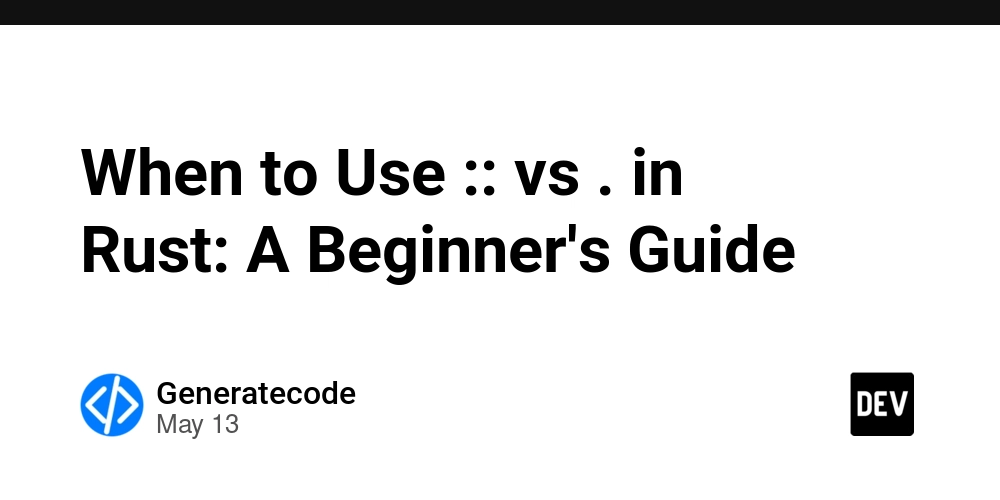When to Use :: vs . in Rust: A Beginner's Guide
Introduction As a newcomer to Rust, understanding the syntax and operators can be a bit daunting. Specifically, you might find yourself asking: when should I use the :: operator versus the . operator? Both operators play crucial roles in Rust's syntax, and grasping their distinctions is key to writing effective Rust code. This article will explore these operators, providing examples to illustrate their use cases, ensuring you feel confident in your understanding as you embark on your Rust programming journey. Understanding the :: Operator The :: operator in Rust is primarily used for namespacing and referring to associated items. It's typically found in the context of: Namespaces: Allows you to access items within a module or a crate. Associated Functions: Invoking functions that are associated with structs, enums, or traits. Example Usage of the :: Operator Here’s a basic example to illustrate how :: works: mod my_module { pub mod my_sub_module { pub fn print_message() { println!("Hello from my_sub_module!"); } } } fn main() { my_module::my_sub_module::print_message(); } In this example, the :: operator is used to access the print_message function that exists within my_sub_module, which is nested under my_module. This encapsulates your code, preventing name collisions and promoting organization. Understanding the . Operator On the other hand, the . operator is commonly used for accessing fields and methods from an instance of a struct or enum. This operator is essential for working with object-oriented concepts like methods and properties in Rust. Example Usage of the . Operator Here's how you can use the . operator in a practical example: struct Person { name: String, age: u32, } impl Person { fn new(name: String, age: u32) -> Person { Person { name, age } } fn display(&self) { println!("Name: {}, Age: {}", self.name, self.age); } } fn main() { let person = Person::new(String::from("Alice"), 30); person.display(); } In this example, the . operator is employed to access the display method and the fields name and age of the Person struct. While we use :: to create a new instance of Person with the new function, we then use . to interact with that instance. Summary of Usage To summarize: Use the :: operator when you need to reference items within modules or invoke associated functions. Use the . operator for accessing methods or properties on instances of structs or enums. Understanding these two operators will help you write clear, organized Rust code while leveraging the language’s powerful module system. Frequently Asked Questions What does the :: operator allow me to do? The :: operator allows you to access associated items in Rust, such as functions or constants defined in a module. It helps in maintaining encapsulation of your code. When should I use the . operator instead of ::? You should use the . operator when you're working with an instance of a type (like structs or enums) and need to access its fields or methods. Are there specific coding practices regarding the use of these operators? Yes! It's advisable to keep your module structure organized. Use :: to clearly define namespaces, and utilize the . operator to interact with instances, ensuring easy readability and maintainability of your code. By now, you should have a clearer understanding of the :: and . operators in Rust. With practice, you will soon feel at ease navigating through Rust's syntax and building robust applications!

Introduction
As a newcomer to Rust, understanding the syntax and operators can be a bit daunting. Specifically, you might find yourself asking: when should I use the :: operator versus the . operator? Both operators play crucial roles in Rust's syntax, and grasping their distinctions is key to writing effective Rust code. This article will explore these operators, providing examples to illustrate their use cases, ensuring you feel confident in your understanding as you embark on your Rust programming journey.
Understanding the :: Operator
The :: operator in Rust is primarily used for namespacing and referring to associated items. It's typically found in the context of:
- Namespaces: Allows you to access items within a module or a crate.
- Associated Functions: Invoking functions that are associated with structs, enums, or traits.
Example Usage of the :: Operator
Here’s a basic example to illustrate how :: works:
mod my_module {
pub mod my_sub_module {
pub fn print_message() {
println!("Hello from my_sub_module!");
}
}
}
fn main() {
my_module::my_sub_module::print_message();
}
In this example, the :: operator is used to access the print_message function that exists within my_sub_module, which is nested under my_module. This encapsulates your code, preventing name collisions and promoting organization.
Understanding the . Operator
On the other hand, the . operator is commonly used for accessing fields and methods from an instance of a struct or enum. This operator is essential for working with object-oriented concepts like methods and properties in Rust.
Example Usage of the . Operator
Here's how you can use the . operator in a practical example:
struct Person {
name: String,
age: u32,
}
impl Person {
fn new(name: String, age: u32) -> Person {
Person { name, age }
}
fn display(&self) {
println!("Name: {}, Age: {}", self.name, self.age);
}
}
fn main() {
let person = Person::new(String::from("Alice"), 30);
person.display();
}
In this example, the . operator is employed to access the display method and the fields name and age of the Person struct. While we use :: to create a new instance of Person with the new function, we then use . to interact with that instance.
Summary of Usage
To summarize:
- Use the
::operator when you need to reference items within modules or invoke associated functions. - Use the
.operator for accessing methods or properties on instances of structs or enums.
Understanding these two operators will help you write clear, organized Rust code while leveraging the language’s powerful module system.
Frequently Asked Questions
What does the :: operator allow me to do?
The :: operator allows you to access associated items in Rust, such as functions or constants defined in a module. It helps in maintaining encapsulation of your code.
When should I use the . operator instead of ::?
You should use the . operator when you're working with an instance of a type (like structs or enums) and need to access its fields or methods.
Are there specific coding practices regarding the use of these operators?
Yes! It's advisable to keep your module structure organized. Use :: to clearly define namespaces, and utilize the . operator to interact with instances, ensuring easy readability and maintainability of your code.
By now, you should have a clearer understanding of the :: and . operators in Rust. With practice, you will soon feel at ease navigating through Rust's syntax and building robust applications!










































































































































































![[The AI Show Episode 156]: AI Answers - Data Privacy, AI Roadmaps, Regulated Industries, Selling AI to the C-Suite & Change Management](https://www.marketingaiinstitute.com/hubfs/ep%20156%20cover.png)
![[The AI Show Episode 155]: The New Jobs AI Will Create, Amazon CEO: AI Will Cut Jobs, Your Brain on ChatGPT, Possible OpenAI-Microsoft Breakup & Veo 3 IP Issues](https://www.marketingaiinstitute.com/hubfs/ep%20155%20cover.png)
















































































































































































































































.jpg?width=1920&height=1920&fit=bounds&quality=70&format=jpg&auto=webp#)
























_Michael_Burrell_Alamy.jpg?width=1280&auto=webp&quality=80&disable=upscale#)





























































































































































































